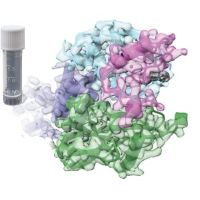Specification
| Description | Recombinant protein from the full-length sequence of Homo sapiens inositol polyphosphate-4-phosphatase type I A (INPP4A), transcript variant d (NM_001134224). |
| Organism | Homo sapiens (Human) |
| Expression Host | Human Cells |
| Tag Info | His or DYKDDDDK. Please contact us if you need further information or require specific designed tag. |
| Purity | Greater than 90% by SDS-PAGE gel |
| Uniprot ID | Q96PE3 |
| Entry Name | INP4A_HUMAN |
| Gene Names | INPP4A |
| Alternative Gene Names | |
| Alternative Protein Names | Inositol polyphosphate-4-phosphatase type I A (Inositol polyphosphate 4-phosphatase type I) (Type I inositol 3,4-bisphosphate 4-phosphatase) (EC 3.1.3.66) |
| Application | Antigens, Western, ELISA and other in vitro binding or in vivo functional assays, and protein-protein interaction studies; For research & development use only! |
| Buffer | Purified protein formulated in a sterile solution of PBS buffer, pH7.2, without any preservatives |
| Endotoxin | Endotoxin level is < 0.1 ng/µg of protein (<1EU /µg) |
| Length | 977 |
| Molecular Weight(Da) | 109956 |
| Protein Sequence | (The sequence of expressed protein may have some variation from the sequence shown below. Please contact us for the exact sequence.) MTAREHSPRHGARARAMQRASTIDVAADMLGLSLAGNIQDPDEPILEFSLACSELHTPSLDRKPNSFVAVSVTTPPQAFWTKHAQTEIIEGTNNPIFLSSIAFFQDSLINQMTQVKLSVYDVKDRSQGTMYLLGSGTFIVKDLLQDRHHRLHLTLRSAESDRVGNITVIGWQMEEKSDQRPPVTRSVDTVNGRMVLPVDESLTEALGIRSKYASLRKDTLLKSVFGGAICRMYRFPTTDGNHLRILEQMAESVLSLHVPRQFVKLLLEEDAARVCELEELGELSPCWESLRRQIVTQYQTIILTYQENLTDLHQYRGPSFKASSLKADKKLEFVPTNLHIQRMRVQDDGGSDQNYDIVTIGAPAAHCQGFKSGGLRKKLHKFEETKKHFEECCTSSGCQSIIYIPQDVVRAKEIIAQINTLKTQVSYYAERLSRAAKDRSATGLERTLAILADKTRQLVTVCDCKLLANSIHGLNAARPDYIASKASPTSTEEEQVMLRNDQDTLMARWTGRNSRSSLQVDWHEEEWEKVWLNVDKSLECIIQRVDKLLQKERLHGEGCEDVFPCAGSCTSKKGNPDSHAYWIRPEDPFCDVPSSPCPSTMPSTACHPHLTTHCSPPPEESSPGEWSEALYPLLTTLTDCVAMMSDKAKKAMVFLLMQDSAPTIATYLSLQYRRDVVFCQTLTALICGFIIKLRNCLHDDGFLRQLYTIGLLAQFESLLSTYGEELAMLEDMSLGIMDLRNVTFKVTQATSSASADMLPVITGNRDGFNVRVPLPGPLFDALPREIQSGMLLRVQPVLFNVGINEQQTLAERFGDTSLQEVINVESLVRLNSYFEQFKEVLPEDCLPRSRSQTCLPELLRFLGQNVHARKNKNVDILWQAAEICRRLNGVRFTSCKSAKDRTAMSVTLEQCLILQHEHGMAPQVFTQALECMRSEGCRRENTMKNVGSRKYAFNSLQLKAFPKHYRPPEGTYGKVET |
Background
| Function | FUNCTION: Catalyzes the hydrolysis of the 4-position phosphate of phosphatidylinositol 3,4-bisphosphate (PtdIns(3,4)P2) (PubMed:20463662, PubMed:15716355). Catalyzes also inositol 1,3,4-trisphosphate and inositol 1,4-bisphosphate (By similarity). Antagonizes the PI3K-AKT/PKB signaling pathway by dephosphorylating phosphoinositides and thereby modulating cell cycle progression and cell survival (PubMed:30071275) (By similarity). May protect neurons from excitotoxic cell death by regulating the synaptic localization of cell surface N-methyl-D-aspartate-type glutamate receptors (NMDARs) and NMDAR-mediated excitatory postsynaptic current (By similarity). {ECO:0000250|UniProtKB:Q62784, ECO:0000250|UniProtKB:Q9EPW0, ECO:0000269|PubMed:15716355, ECO:0000269|PubMed:20463662, ECO:0000269|PubMed:30071275}.; FUNCTION: [Isoform 4]: Displays no 4-phosphatase activity for PtdIns(3,4)P2, Ins(3,4)P2, or Ins(1,3,4)P3. {ECO:0000269|PubMed:9295334}. |
| Pathway | Signal transduction; phosphatidylinositol signaling pathway. |
| Protein Families | Inositol 3,4-bisphosphate 4-phosphatase family |
| Tissue Specificity | Isoform 1 is expressed in the platelets, MEG-01 megakaryocytes and Jurkat T-cells. Isoform 2 is expressed in the brain. {ECO:0000269|PubMed:11485317}. |
QC Data
| Note | Please contact us for QC Data |
| Product Image (Reference Only) |  |

